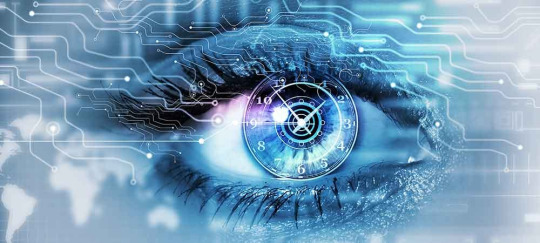#computer vision
Text

Conversational AI Solutions by AlignMinds in USA
Discover the future of customer interaction with AlignMinds' cutting-edge Conversational AI solutions. Based in the USA and serving clients globally, we specialize in creating intelligent, seamless, and engaging AI-driven communication platforms. Enhance your customer experience, streamline operations, and drive growth with our innovative technologies.
#ConversationalAI #AIDriven #CustomerExperience #GlobalServices #TechInnovation #SmartSolutions #AIChatbots #DigitalTransformation
0 notes
Text
Computer Vision: Transforming Image and Video Analysis with AI
Computer vision is a rapidly developing field of artificial intelligence (AI) that's revolutionizing the way we see and understand the world through images and videos. By harnessing the power of machine learning and deep learning algorithms, computer vision enables computers to interpret and analyze visual data, extract meaningful information, and even take actions based on their findings.

Here's a breakdown of what computer vision is and how it's transforming image and video analysis:
What is Computer Vision?
Imagine giving a computer the ability to see like a human. That's essentially what computer vision strives for. It equips computers with the capability to:
Interpret visual data: Analyze digital images and videos, including identifying objects, people, scenes, and activities.
Extract information: Derive meaningful insights from the visual data, such as object attributes, spatial relationships, and actions.
Make decisions: Based on the extracted information, computer vision systems can make recommendations or trigger actions.
How Does Computer Vision Work?
The core concept behind computer vision involves mimicking the human visual system. Here's a simplified breakdown of the process:
Image Acquisition: Capturing visual data through cameras or video feeds.
Preprocessing: Preparing the data for analysis, which may involve noise reduction, normalization, or format conversion.
Feature Extraction: Identifying and isolating key characteristics from the images, such as edges, shapes, textures, or colors.
Machine Learning/Deep Learning: Using algorithms trained on vast amounts of labeled data to recognize patterns, classify objects, and make sense of the visual information.
Transforming Image and Video Analysis
Computer vision has significantly transformed image and video analysis by:
Automation: Automating tasks that were previously manual, such as image classification, object detection, and content tagging. This saves time, improves efficiency, and reduces human error.
Accuracy: Deep learning algorithms can achieve high levels of accuracy in image and video analysis, surpassing human performance in specific tasks.
Scalability: Computer vision systems can handle massive amounts of visual data, making them ideal for large-scale applications like video surveillance or medical image analysis.
New Applications: Computer vision has opened doors to entirely new applications in various fields, including self-driving cars, robotics, medical diagnosis, and augmented reality.
Overall, computer vision is a powerful tool that's fundamentally changing how we interact with and understand the visual world. As the technology continues to evolve, we can expect even more innovative applications and advancements in image and video analysis in the years to come.
0 notes
Text
Captcha refused to let me fail today

#I guess i made too many mistakes with the orevious ones#omat#captcha#ai#computer vision#computer#ai fail
0 notes
Text
Difference Between Computer Vision And Machine Learning
Computer vision and machine learning intersect but have distinct purposes in AI. Computer vision understands visual data like images, while machine learning teaches computers without explicit programming. This article will allow you to understand the difference between computer vision and machine learning in depth.
What Is Computer Vision?
Computer Vision is a broad field of AI that enables computers to process, examine, and make sense of what they see. In the real world, there are many things. Things might look a lot alike, but the little things are what make them different. A lot of people think that computer vision is most often used for picture recognition. What we want to do is make computers that can see and understand pictures just like our eyes do. It's really amazing how easily our eyes can process and understand pictures. People have traits that make them special. Computer vision tries to give computers those traits so that computers can understand and study complicated systems as well as or better than people.
What is Deep Learning?
In order for computers to learn things that people naturally do, deep learning, a subfield of machine learning and AI based on artificial neural networks, attempts to mimic how the brain functions. The study of algorithms based on the organization of the human brain is known as deep learning. These methods help computers learn and understand in a way that is similar to how our brains do it. Setting up a decision-making process that works like the way our brains do is what it does. In machine learning, it's a way to figure out what the data means. That and tools like it are some of the most important AI tools right now. At first, it was made so that machine learning could handle input-output patterns that were not simple. Deep learning is now a cutting-edge technology used for a variety of purposes across many industries.
Difference between Computer Vision and Deep Learning
Computer Vision is the field that studies how to make machines understand and interpret visual data from the real world, like pictures and videos.
Deep Learning is a type of machine learning that uses algorithms that are based on how the brain's neural networks are structured and work. These algorithms let machines learn from a lot of data.
Methodology: Computer Vision processes, analyzes, and makes sense of visual data using a variety of methods and algorithms, such as object detection, image processing, and feature extraction.
Deep Learning uses deep neural networks, which are artificial neural networks with many levels, to learn from raw data like images, text, and audio and automatically pull out features.
Approach to Learning: Traditional machine learning techniques like SVMs (Support Vector Machines) and decision trees are frequently combined with hand-made features in the field of computer vision.
Neural networks are used in deep learning to automatically learn how to organize data in a hierarchical way, so feature engineering doesn't have to be done by hand.
Performance and Accuracy: Deep Learning, especially deep neural networks, often does the best job of computer vision tasks like classifying images, finding objects in images, and separating images into different parts.
Traditional computer vision methods can work for some jobs, but they might not be as good at dealing with complex and unstructured data as deep learning methods.
Data Needed: Computer Vision frequently needs named datasets and a lot of feature engineering to train models well, which can take a lot of time and work.
A lot of labeled data is needed to train deep learning algorithms, especially convolutional neural networks (CNNs). However, these algorithms can automatically learn important features from raw data.
Because the features and decision-making process are clearly outlined by the algorithms and engineers, traditional Computer Vision methods frequently produce results that are easier to understand.
A lot of people don't like deep learning models because the learned representations can be hard to understand. This is especially true for deep neural networks with many levels.
Computational Difficulty: Deep Learning models, especially deep neural networks with many layers, need a lot of computing power and may need powerful devices for training and inference, like GPUs (Graphics Processing Units) or TPUs (Tensor Processing Units).
Although traditional Computer Vision techniques might be easier on computers and better for places with limited resources, they might not be as good as deep learning methods.
1 note
·
View note
Text

Discover the workflow for implementing computer vision in quality control with our easy-to-follow flowchart. Navigate through stages including data acquisition, preprocessing, model selection, training, testing, and deployment. Simplify the process of enhancing quality control with advanced visual inspection systems. Perfect for quality control professionals and computer vision enthusiasts. Stay updated with Softlabs Group for more insights into cutting-edge AI applications!
0 notes
Text
1 note
·
View note
Link
Status update by Maruful95
https://www.fiverr.com/s/mw4EmV
0 notes
Text
Things You Need to Know About Computer Vision
Looking to know in detail about computer vision. Explore this blog to know about what is computer vision, its benefits, types, use cases, and more.
0 notes
Text

Day 38/100 days of productivity | Wed 27 Mar, 2024
Presented the computer vision paper at data science reading group, it went well! We all had a really good discussion about the paper!
I was in meetings all day so didn’t really have a chance to work on anything solid.
In one of my meetings, I presented my progress on a project to my new boss, she seemed pleased and wanted me to continue working on it. It has a very very very tight deadline (in the next 2 days), so I’ll do as much as possible before then!
My apartment had a cookie-decorating class! I had a lot of fun making these!
1 note
·
View note
Text
What Is Computer Vision?
In a world where technology is continually being shaped and reforming the limits of the possible, computer vision has emerged to take its place in front of these as a formative force that bridges the gap between digital computation and subtler complications of the visual realm. Computer vision is part of the bedrock of AI—one of those fields that has exploded over the past half-decade, powered…

View On WordPress
0 notes
Text
10 Important Computer Vision Use Cases for Construction in 2024
viAct's computer vision for construction management not only automates construction site monitoring but elevates it to a strategic level by providing dynamic insights, facilitating proactive decision-making, and optimizing the overall construction management process.
0 notes
Link
Status update by Maruful95
Hello there,
I'm Md. Maruful Islam, is a skilled trainer of data annotators from Bangladesh. I currently view my job at Acme AI, the pioneer in the data annotation sector, as an honour. I've improved my use of many annotation tools throughout the course of my career, including SuperAnnotate, Supervise.ly, Kili, Cvat, Tasuki, FastLabel, and others.
I have written consistently good annotations, earning me credibility as a well-respected professional in the industry. My GDPR, ISO 27001, and ISO 9001 certifications provide even more assurance that data security and privacy laws are followed.
I genuinely hope you will consider my application. I'd like to learn more about this project as a data annotator so that I may make recommendations based on what I know.
#data annotation#image annotation services#machinelearning#computer vision#video annotation#annotation
0 notes
Text


[2/100 days of productivity]
Spent most of the day on my computer vision assignment, writing the code and later on writing the report. It was submitted on time.
The good thing is I've spent 7 hours of concentrated work, i haven't been able to do that since a very long time.
Used the 50min/10min pomodoro technique. I am trying to advance in my reading during the breaks. I've been suffering from constant reading slumps.
#100 days of productivity#Sophie's world#Computer vision#engineering student#Computer science student
1 note
·
View note
Text
Computer Vision Engineer Essentials | Self-Learning | BrainyBits
Computer Vision Engineer Essentials

Computer Vision Engineer Essentials teaches Python basics, machine learning, deep learning, and computer vision. Students learn to code in Python, understand machine learning concepts, delve into deep learning techniques, and apply them to solve problems in computer vision.
Requirements
Basic Statistics for Data Science course completion is mandatory
Basic English
Laptop or Desktop with 8GB RAM and i5 processor
Reliable Internet Connection
Consistancy Learning
Enthusiasm towards programming
What you’ll learn
Python basics: Variables, loops, conditionals, functions, object oriented programming, coding exercises.
Machine learning: Supervised, unsupervised learning; building real world models.
Deep learning: Neural networks, activation functions, optimization, TensorFlow, PyTorch, complex tasks.
Computer vision: Image interpretation, object detection, classification, facial recognition, segmentation.
Practical learning: Hands-on projects, guided assignments, real-world applications, personalized feedback.
Strong Python foundation, machine/deep learning skills, and computer vision expertise.
0 notes
Text






Day 19/100 days of productivity | Fri 8 Mar, 2024
Visited University of Connecticut, very pretty campus
Attended a class on Computer Vision, learned about Google ResNet, which is a type of residual neural network for image processing
Learned more about the grad program and networked
Journaled about my experience
Y’all, UConn is so cool! I was blown away by the gigantic stadium they have in the middle of campus (forgot to take a picture) for their basketball games, because apparently they have the best female collegiate basketball team in the US?!? I did not know this, but they call themselves Huskies, and the branding everyone on campus is on point.
#100 days of productivity#grad school#computer vision#google resnet#neural network#deep learning#UConn#uconn huskies#uconn women’s basketball#university of Connecticut
9 notes
·
View notes
